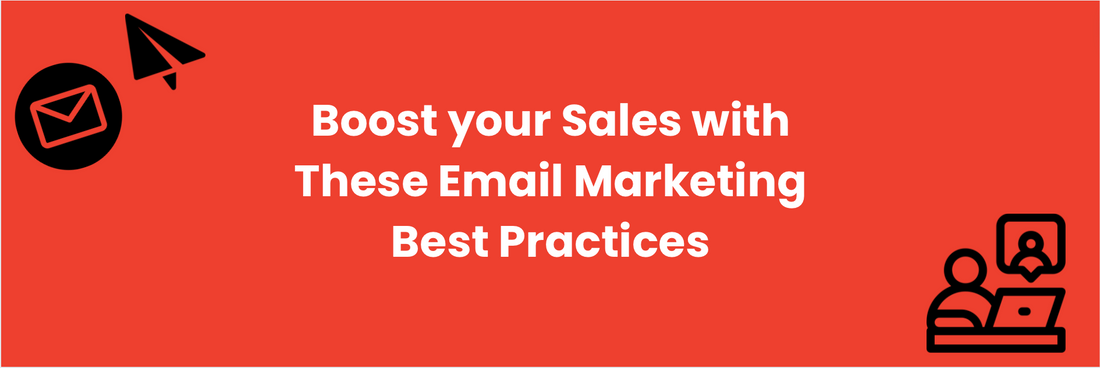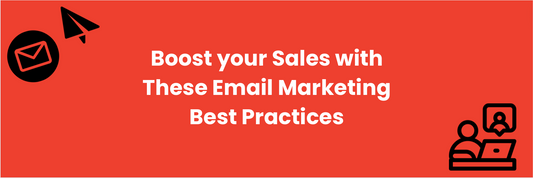Contrary to popular belief, email remains one of the most effective tools for businesses to connect with their audience and drive sales. When executed strategically, email marketing can yield impressive results and contribute significantly to the bottom line.
Wondering how you can leverage email in your marketing efforts to drive sales?
Having a hard time growing your email list organically and attracting quality subscribers genuinely interested in your products or services?
You’ve come to the right place. Let's dive into some tried-and-tested best practices that we’ve experienced with our clients:
1. Build a Quality Email List
Your email list is the backbone of your email marketing strategy. Prioritize quality over quantity. Quality subscribers are more likely to open your emails, engage with your content, and ultimately convert into customers.
Additionally, focus on building your list organically by encouraging website visitors and customers to subscribe through compelling calls-to-action (CTAs) and opt-in forms on your website, blog, and social media channels.
Lastly, make it a point to regularly clean and update your email list to remove inactive or disengaged subscribers. This helps improve your email deliverability rates and ensures that you're only sending emails to people who are genuinely interested in hearing from you.
2. Personalization is Key
Personalization goes a long way in capturing your audience's attention and fostering a sense of connection. This is key to an effective email marketing strategy.
Address your subscribers by their first names and segment your email list based on demographics, purchase history, or behaviour. This allows you to send relevant emails to specific segments of your audience, increasing engagement and driving conversions. You can also utilize dynamic content blocks to display different products or messages based on individual subscriber data.
3. Use Compelling Subject Lines
Your subject line is the first thing recipients see in their inbox, making it a crucial element in determining whether your email gets opened or not. Crafting a subject line that commands attention requires a delicate balance of conciseness and compelling content.
To capture the interest of your audience, consider creating subject lines that evoke curiosity, highlight a sense of urgency, or promise a solution to a pressing pain point. By piquing user interest or offering a timely solution to their needs, you increase the likelihood of them opening your email to discover more.
However, make sure you’re avoiding resorting to spammy language or deceptive tactics in an attempt to boost open rates. These tactics not only risk alienating recipients but can also tarnish your brand's reputation and credibility. Transparency and authenticity should be at the forefront of your email marketing efforts, ensuring that your subject lines accurately reflect the content in the email and uphold the trust of your audience. By striking the right balance between engaging content and ethical practices, you can optimize your email open rates.
4. Create Engaging Content
Your subscribers want valuable content that speaks to their interests and needs. Offer a variety of content types such as informative articles, product updates, or exclusive promotions to keep them engaged. Whether it's providing insights, keeping them informed, or offering deals, ensure every email delivers something of worth.
You can utilize a blend of text, images, and videos to make your emails visually appealing and easy to consume. Did you know that visual elements not only grab attention but also enhance understanding? Experiment with different formats to find what resonates best with your audience and keeps them coming back for more.
5. Optimize for Mobile
With the majority of emails being opened on mobile devices, it's crucial to prioritize mobile-friendliness in your email campaigns.
Choose responsive email templates that adapt well to various screen sizes. As a rule of thumb, keep your design simple and avoid using small fonts or overly large images that could slow down load times. Always test your emails across different devices and email clients to ensure a consistent experience for all subscribers.
6. Implement A/B Testing
A/B testing allows you to experiment with different elements of your emails to optimize performance. Test variations of subject lines, call-to-action buttons, email copy, and design elements to see what resonates best with your audience. Analyze the results of your tests and use the insights gained to refine your email marketing strategy further.
A/B testing allows you to fine-tune your email campaigns for better results. You can experiment with variations of subject lines, call-to-action buttons, email copy, and design elements to identify what resonates best with your audience.
Once you’ve set up A/B testing on your emails, analyze the results by drawing insights from the emails to inform your email marketing strategy further. This iterative process helps provide continuous improvement, leading to more effective and engaging campaigns.
7. Focus on Timing
Timing plays a crucial role in the success of your email campaigns. You can explore sending emails at various times and on different days of the week to identify the ideal schedule for your audience.
Take into account factors like time zones, industry trends, and the behaviour patterns of your subscribers to ensure your emails are delivered at the right times. By strategically scheduling your emails, you can enhance their impact and the engagement levels of the email.
8. Monitor and Analyze Performance
Regularly tracking the performance of your email campaigns is key for optimizing their effectiveness.
You can keep an eye on key metrics like open rates, click-through rates, conversion rates, and unsubscribe rates to gauge how well your emails are resonating with your audience. You can also look for trends and patterns in your data to pinpoint areas for improvement and optimization. Leveraging email marketing analytics tools can provide deeper insights into subscriber behaviour and preferences, allowing you to fine-tune your strategy for greater success.
As mentioned above, email marketing continues to play a big role in driving sales and nurturing customer relationships in today's digital world. By following these best practices and continuously refining your approach based on data and insights, you can leverage email marketing to achieve your business goals. Remember, success in email marketing is not just about sending emails but sending the right emails to the right people at the right time, with the right message.
Contact us to learn more about our email marketing services here.



